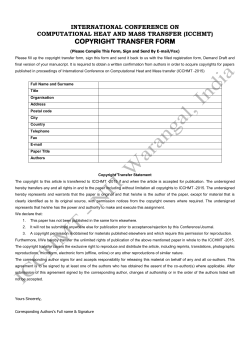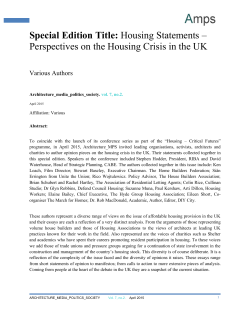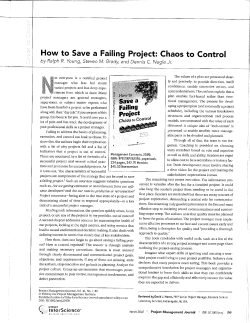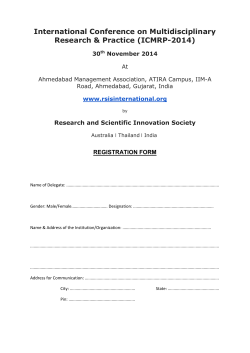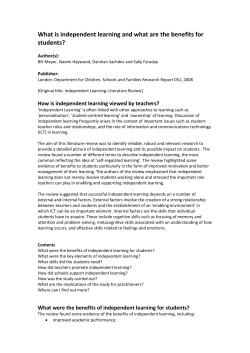
BMB 174 Key for Problem Set 1: Proteolysis 1. Kenniston et al 2003
BMB 174 Key for Problem Set 1: Proteolysis 1. Kenniston et al 2003 examined ClpXP degradation of substrates with different stabilities and showed the relationship between substrate degradation and ATP consumption. (25 points total) a. The authors show that two important steps of substrate degradation can be rate limiting and were able to decouple them. i. What were the two parameters? (2 points) The two parameters are rate of protein unfolding and rate of translocation. (kden and ktrans) ii. Explain the properties of titin-I27 and how these properties motivated the author’s choice in choosing it as a substrate. The authors mention 4, but you should mention one more specific to titin-I27 for a total of 5. (5 points) a) Availability of variants displaying a range of local protein stabilities at the site of ssrA tagging (the C-terminus) b) Native stabilities that are known or can be determined c) Well-characterized stability to mechanical unfolding by AFM d) Existence of variants that are soluble e) Ability to trap titin in the completely unfolded state using carboxymethylation, which cleanly uncouples unfolding and translocation f) Presence of buried tryptophan for easy fluorescent readout of folding status. iii. Explain the importance carboxymethylation and its connection to decoupling the two parameters in part (i). (3 points) The molecular mimic allowed the authors to assess wild-type and mutant titin variants in an already unfolded state. By carboxymethylating two cysteine residues buried in the hydrophobic core with iodoacetic acid, the authors observed all of the indicators of a denatured, unfolded protein in normal buffers without actually denaturing it first. Since these variants are already denatured, the authors can ignore kden and focus on ktrans as the rate-limiting step. The authors could also more easily calculate values for kdeg. b. The authors concluded that translocation is rate limiting for degradation of denatured titin substrates, and give ktrans = 4.3 min-1 for titin, a 127 amino acid long protein. i. What would you estimate the ktrans of a protein half the length of titin, say ~60 amino acids? What about the ktrans of a protein twice the length of titin, say ~250 amino acids? Explain your reasoning and cite the figure (hint hint). (4 points) Figure 3C shows that ktrans is dependent on length. For a protein of ~60 amino acids, the ktrans would be estimated to be twice as fast, around 8 min-1. For a protein of ~250 amino acids, the ktrans would be estimated to be two times slower, about 2 min-1. ii. kdeg was measured to be 0.3 min-1. Find the value for ktrans in the paper, then use the equation the authors used in the paper to calculate τden . Show your work. (5 points) τden=1/kden kden=(ktrans*kdeg)/(ktrans-kdeg) kden=(4.3 min-1*0.3 min-1)/(4.3min-1-0.3min-1)=0.322 min-1 τden=1/0.322 min-1= 3.1 min iii. Calculate the amount of ATP consumption during degradation of native titin-I27ssrA variants for the τden that you calculated from part (ii). Show your work. (4 points) ATP=144 mol *min-1*τden+100 mol ATP=144 mol*min-1*3.1min+100 mol=546 mol c. Write down at least one question you plan on asking the presenter of this paper (2 points). 2. Smith et al 2007 showed that a conserved motif of the 19S regulatory ATPase of the 20S proteasome induces gate opening into the 20S proteolytic core. (25 points total) a. What are the advantages to studying the PAN-20S archaeal system when investigating proteasome function? (3 points) Does not require ubiquitin conjugation for proteolysis Contains only one type of α and β subunits Complexes assemble when expressed in E. coli b. What is the evidence that the C-terminus is located at the interface of the ATPase-20S complex? (5 points) In Figure 1C, the authors observed that if the PAN-20S complex was formed first by using ATPγS before treating with carboxypeptidase B, PAN retained some ability to stimulate peptide hydrolysis. From an earlier study (Goldberg, 2007), the authors have found that the C-terminus is responsible for stimulating peptide hydrolysis. Hence, the authors inferred that the C-terminus was partially protected from CpB treatment in the complex, and is therefore somewhere at the interface. c. Can you think of one other method that the authors could have used instead of EM to verify that the HbYX motif is required for PAN-20S complex formation? (2 points) They could have used native gel electrophoresis or even native mass spec to see if complexes were formed. This paper is from 2007, so native gel electrophoresis is probably more likely than native mass spec. d. Draw a possible favorable interaction between lysine66 and the free carboxyl group of the HbYX motif and describe what type of interaction it is. (1 points) The interaction is a salt-bridge, but either of these interactions will suffice: Hydrogen-bonding: H O H N H H O NH O Electrostatics: O NH3 O NH O e. The authors make several conclusions based on the evidence presented in this paper. i. List the conclusions that are valid based on the evidence, and the ones that are not valid because they are limited by the resolution of cryoEM. (12 points) Authors’ conclusions supported by experimental evidence: PAN’s C-terminal arginine residue is required to stimulate 20S gate opening. The authors showed this by treatment with carboxypeptidase B (CpB), which did not affect the ability of the 20S proteasome to hydrolyze the fluorogenic substrate and did not alter PAN’s ATPase activity or ability to unfold GFP-ssrA. However, CpB did cause PAN to lose its ability to stimulate peptide entry. They verified this with treatment with carboxypeptidase A (CpA), which cleaves after hydrophobic residues instead. This treatment had not effect on PAN’s ability to stimulate peptide entry. The mutations summarized in Table 2 and their effects on peptide hydrolysis show that Y429 and L428 are required to stimulate 20S gate opening. Upon ATP binding to proteasomal ATPases, the HbYX motif of the Ctermini dock into pockets in the 20S α ring. Based on the W430 data, the HbYX motif does seem to go from an aqueous environment to a hydrophobic environment, probably by docking into the 20S α ring. The polarization data in figure 2 also exemplify the formation of a complex and the change in environment for the mutant tryptophan. Lys66 of the α ring is required for PAN binding to the 20S. The authors mutate this lysine to alanine and show that the fluorescence spectrum of the terminal tryptophan did not change after treatment with ATPγS. Seven residue peptides corresponding to PAN’s C-terminus were enough to stimulate peptide degradation by the 20S proteasomes. The author’s showed this by incubating these short peptides with the proteasome, and then monitored gate opening by LFP hydrolysis. Peptide degradation was observed. Authors’ conclusions limited by the resolution of cryoEM: The pockets themselves may not be resolvable with cryoEM. Even if they are, the position of Lys66 is definitely not resolvable, nor are the reverse turn loops or the helices. It is therefore difficult to make exact conclusions about the structure of the complex and its docking modes by cryoEM. The structure itself does not support the conclusion that PAN and PA26 Ctermini bind to the same pockets. The authors did observe that both can inhibit the binding of PAN to the 20S, but the structure still does not support this claim. The structure also does not support the conclusion that gate opening by ATPases requires docking by only a subset of C-termini to the 20S pockets. The authors do claim that a “wobbling” structure supports this apparent asymmetry, but cryoEM would not be able to resolve different contacts between the C-termini. C-termini interactions would be expected to interact heterogeneously, and would not show up in particle reconstructions. f. Write down at least one question you plan on asking the presenter of this paper (2 points). 3. Pierce et al 2013 propose a mechanism whereby proteasomal substrates and the cullinbinding protein Cand1 collaborate to regulate the SCF-complex macromolecular machine. (25 points total) a. The authors used FRET to examine SCF assembly. i. What were the two fluorescent entities the authors used to measure FRET? (2 points) Fluorescent dye: TAMRA Cyan fluorescent protein: CFP ii. Given the spectra below, label the donor and the acceptor. Also label the excitation and emission peaks for the donor and the acceptor and explain how these fluorescent entities were able to achieve FRET. (2 points Ex Em CFP Ex Em TAMRA CFP was the donor and TAMRA is the acceptor. The peak emission for CFP was 478 nm, and the peak excitation for TAMRA is about 550 nm. Since the emission from the donor and the excitation from the acceptor show a good amount of spectral overlap, FRET is possible. The emission from the donor can excite the acceptor, which we see on Figure 1A. b. The authors found that Cand1 acts as an F-box exchange factor. i. For each panel in Figure 4, draw schemes for the reactions that are monitored. Then explain the implications these findings have about Cand1 and SCF complexes in vivo. (10 points) Panel A: Reaction is: Cul1•skp1•β-TrCP + skp1•Fbxw7 -> Cul1•skp1•Fbxw7 + skp1•βTrCP Reaction occurs at 5 x 10-6 s-1 Panel B: Reaction occurs at 0.07 s-1 Panel C: Lanes 1-6: Preformed SCFFbxw7 incubated with skp1•β-TrCP + CycE substrate Lanes 7-11: Preformed SCFβTrCP incubated with Fbxw7-Skp1 + CycE substrate Lanes 12-16: Preformed SCFβTrCP incubated with skp1•Fbxw7 + CycE substrate and Cand1 The ability of Cand1 to mediate exchange between different pre-incubated Fboxes is important in the formation of new F box proteins in the cell, so that a variety of substrates can be degraded. Cand1 allows for the formation of new SCF complexes by mediating access of newly formed F box proteins to Cul1. ii. Explain the significance of a protein exchange factor like Cand1 promoting equilibrium between a scaffold and a large number of interacting partners. (ie why is it important that the cell has this capability?) (4 points) In the context of the proteasome especially, the necessity for equilibrium between many binding partners is important for the broad range of degradation targets. Without regulation and the possibility for exchange of many targets, the proteasome may not be able to effectively manage misfolded or damaged proteins and/or control the lifetimes of properly folded proteins. c. Explain how the data in this work reconciles previously conflicting models for Cand1 function in vitro (as a stoichiometric inhibitor of SCF assembly and ligase activity) and in vivo (as a positive regulator of SCF and other CRLs). (5 points) Previous biochemical work had suggested Cand1 was an inhibitor of SCF complexes in vitro. In vivo genetic studies suggested that Cand1 promotes SCF function. The data in this paper instead show that Cand1 actually acts as an exchange factor. The experiments show that in vivo (Figure 5), Cand1 promotes the assembly of new Fbox proteins with pre-existing Cul1 molecules. The authors also show that in vitro (Figure 4), Cand1 can stimulate SCF activity by enabling an Fbox protein-Skp1 complex to access a previously occupied Cul1 by a different F-box protein-Skp1 complex. Cand1 promotes the exchange of multiple F box proteins on the Cul1 scaffold. The authors were also able to build upon previous studies that coupled the cycles of Cand1 and Nedd8. The authors propose that Cand1 couples with cycles of Nedd8 conjugation and deconjugation, a coupling which enables the CRL complexes to switch between drastically different states: the exchange regime mediated by Cand1, and the Nedd8 stable state. Lastly, the authors propose an explanation to explain prior genetic studies that Cand1 deficiency causes partial reduction of function for some SCF complexes, but has no effect on others. The authors suggest that the steady-state distribution of SCF complexes and the effect of Cand1 on this distribution accounts for this behavior. The results shown in this paper also suggest that Cand1 biases the assembly of SCF complex in favor of F box proteins in which substrates are available. d. Write down at least one question you plan on asking the presenter of this paper (2 points). 4. Matyskiela et al 2013 show that the regulatory particle of the 26S proteasome switches from a preengaged to a translocation-competent conformation with cryo-EM. (25 points total) a. The authors solved the structure of the substrate-bound proteasome. i. Can you think of a technique that the authors could have done to verify the presence of GFP in the substrate-bound proteasome? (2 points) Correlated fluorescence and cryo-EM microscopy could have been performed to verify that the translocating substrate actually was the GFP fused model substrate. Correlated fluorescence and cryo-EM techniques are typically used to look at localization of cellular structures, but the authors could have at least gotten a statistical representation of GFP correlated with their particles. ii. The authors tested the ATP hydrolysis activity of the mutant enzyme to ensure that it was still functional. Why did they also look at structural organization of the enzyme as compared to wild-type (Supplementary Fig 2b)? (4 points) While functionality is important, structural biologists also need to be assured that mutants look the same as their wild-type counterparts. If the enzyme was still performing ATP hydrolysis in the expected manner but looked drastically different, this could imply some interesting compensatory mechanisms or be using a mechanism entirely different from mechanism of interest in the wildtype. In other words, the authors are using the mutant to give them insight into the real enzyme, and a drastically different mutant (enzymatically or structurally) will likely not give them biologically relevant information. b. The authors observe a drastic repositioning of Rpn11 from the unbound state to the substrate-bound state. Explain what was previously known about Rpn11, and explain the significance of the new observations of this paper concerning Rpn11. (5 points) Previous information: Rpn11 is part of the lid subcomplex of the regulatory particle. It is a nonessential deubiquitinating enzyme (DUB), and forms a dimer with Rpn8 which projects toward the center of the regulatory particle. Rpn11 can remove entire ubiquitin chains from the substrate by cleaving the isopeptide bond of the proximal ubiquitin moiety. This deubiquitination activity was shown to depend on ATP hydrolysis by the proteasome. New information: Without substrate engagement, Rpn11 is not in position to allow substrate-bound ubiquitin to reach the DUB active site. Figure 3a shows that Rpn11 is off to the side of the N ring, behind the Rpt4-Rpt5 coil-coil. Upon substrate engagement, Rpn11 shifts by 18 Å toward center of regulatory particle. The authors observe that in the substrate bound state, the residues making up the catalytic groove to Rpn11 are directly en route to the catalytic pore for the substrate-attached ubiquitin. The authors propose that Rpn11 serves as a gatekeeper to the core. c. The authors also observed some important changes in the heterohexameric ATPase ring. They observe that the substrate-free Rpts are oriented in a spiral staircase, with Rpt3 situated at the top, and Rpt2 at the bottom. i. Explain the authors’ proposed changes of the Rpts before and after substrate engagement, and how they propose the substrate is translocated through the pore. (2 points) Upon substrate engagement, the Rpts rearrange to a more uniform height. The authors propose that the Rpt ring adopts the spiral conformation with a larger central cavity as soon as a substrate polypeptide is engaged in the central pore. The rings then undergo coordinated ATP hydrolysis to tilt individual AAA+ domains, generating a power-stroke that partially propels the translocating polypeptide through the central pore. The authors propose that after each power stroke, the ATPase subunits return to the spiral formation, and repeats the process until the substrate has been completely translocated. ii. Assuming that the mechanism the authors propose is correct, explain what you would expect of ATP hydrolysis experiments of individual Rpt subunits. In other words, would you expect all six subunits to exhibit the same amount of ATP hydrolysis activity? Why or why not? (10 points) Given the shapes of the substrate free, the preengaged, and the substrateengaged structures, we would not expect ATP hydrolysis to be equal across all six subunits. For one, they do not engage the incoming substrate at the same time in their spiral staircase orientation. And if the substrate was being transported in a concerted motion with multiple contributions from the Rpts, we would expect the Rpts at the top of the staircase require different amounts of energy than the Rpts near the bottom of the staircase. d. Write down at least one question you plan on asking the presenter of this paper (2 points).
© Copyright 2025

